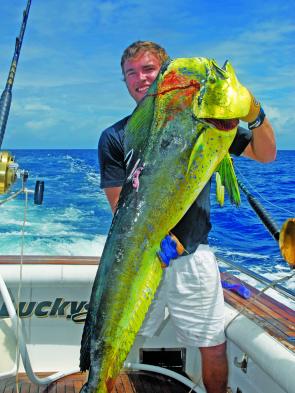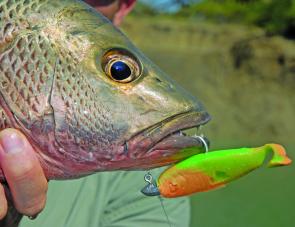November is one of the most challenging months to fish the offshore grounds wide of the Gold Coast. The winter species on the close reefs become fewer in number as the water temperature starts to rise, and the summer pelagic action hasn’t generally begun.
Despite this, there are often some surprising opportunities and it is a good month to get all the gamefishing gear out and start to do some prospecting. The run of small black marlin doesn’t generally show up until mid December, but some seasons a few stripies, medium blacks and the odd sailfish can turn up, and the first run of mahi mahi often begins this month. A few seasons ago we had a good run of small wahoo all through November.
Reports from the more northern gamefishing ports show that very few small black marlin have been caught so far, although there have been some reasonable sessions out from 1770. Hopefully this run of fish will pick up in coming months, but the chances are the marlin season will be a slow one where the juvenile black marlin are concerned.
Nevertheless, a few days trolling always gets the systems set up, the lures tuned and the game plans hatched. If you want to troll this month, try working the grounds east of Jumpinpin or the Tweed. Head out until you hit clean blue water.
The first of the coral spawn lines in the current will appear this month as the East Australian current starts to move down the coastline. This is the best area to target mahi mahi. Troll a spread of five medium-sized skirted lures on 8-15kg tackle and work these current lines. These are fish highways and mahi mahi hunt along them. Pay careful attention for floating objects as these fish love hanging around any logs, floats or trap buoys. If you find a big floating object troll past it, and if you have pilchards or live baits cast them directly adjacent to the shady area under the debris.
November often produces some nice mahi mahi from 6-12kg and they tend to be the first warm water pelagic to arrive off the Gold Coast. Also expect striped tuna, the odd wahoo (very seasonal dependant) and there is always the chance of a marlin.
On the 36-fathom line the snapper have all but finished, but there will still be a few squire about and the odd pearl perch. In closer to shore expect teraglin and tailer. It is a good month to stack up on bonito and small tuna for the coming mackerel season. The inshore reefs will also produce a few mulloway and cobia on live baits, with most of the mulloway being caught at night.
On the 50-fathom line there should still be a few pearlies, amberjack and Samson depending on the current. It can be quite a good month for jigging metal lures and this is a much more effective tactic if the current is strong. Overall, however, November is a transitional month on the offshore grounds, and fishing can be very tough.
We should start to get a few cracking thunderstorms this month which will liven up the fishing greatly. This type of weather really brings the mangrove jacks and trevally on the chew and the big schools of small herrings start to proliferate throughout the entire estuary. This attracts a wide variety of predators.
I like fishing the Nerang River and the canal systems this month and run out tides at dawn and dusk can produce some great fishing for jacks on trolled lures. Work the rock bars and canal corners and hang on. Getting busted up repeatedly is just part of this game and nearly all the bites come by working very close to structure. I reckon over the years roughly third of all the jacks I’ve hooked on the troll have kept my lure, regardless of the line being used.
Good lures to use include any deep runners that bang into the bottom with a slim profile and a running depth of 3.5-6m. Trolling into the current means you can keep a slower troll speed and the lure stays in the strike zone longer. Use bright colours in dirty water and chrome or gold-based colours when conditions are clear.
The end of the Seaway walls can be productive this month with tailor, tarpon and school jews on the prowl on both soft plastics and metal jigs. Remember the new size limit on jews is 75cm and fish under this size must be returned.
Whiting increase in number this month and the Nerang and Pimpama rivers and Coombabah Creek should all produce a few elbow slappers on wrigglers and soldier crabs. Small shrimp fished three or four to a hook are a good alternative. Small poppers can also be effective when the whiting are up on the flats chasing shrimp.
By November most of the flathead have spawned and the big females start to move off the spawning beds and penetrate back up river. There should still be a few around the Seaway and Jumpinpin but the peak of the flathead season has already passed.
I can’t remember a season where the water throughout the estuary was so consistently filthy, which has made lure fishing extremely difficult. A lot of locals attribute this filth to the constant development up the Coomera and Pimpama rivers and around Jacobs well. Even an hour into the run-out tide, a brown blanket of sludge moves down the estuary and makes fishing very tough. I haven’t seen clean clear water at the Aldershots, Whalleys Gutter or the Neverfails for over six months. I used to prefer to do my flathead fishing on the run-out tide but the water quality makes it hopeless.
Overall, work hard, get up early and don’t expect miracles on the water this month. Despite this, it is definitely one of the best months to chase mangrove jacks.
Reads: 6037
Pay careful attention for floating objects as mahi mahi love hanging around any logs, floats or trap buoys.

By November most of the flathead have spawned and the big females start to move off the spawning beds and penetrate back up river.

It is definitely one of the best months to chase mangrove jacks.




